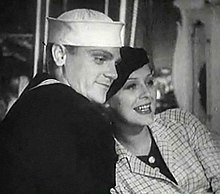
James Francis Cagney Jr. was an American actor and dancer. On stage and in film, he was known for his consistently energetic performances, distinctive vocal style, and deadpan comic timing. He won acclaim and major awards for a wide variety of performances.

Gloria Frances Stuart was an American actress, visual artist, and activist. She was known for her roles in Pre-Code films, and garnered renewed fame late in life for her portrayal of Rose Dawson Calvert in James Cameron's epic romance Titanic (1997), one of the highest-grossing films of all time. Her performance in the film won her a Screen Actors Guild Award and earned her nominations for the Academy Award for Best Supporting Actress and the Golden Globe Award for Best Supporting Actress – Motion Picture.

USS Macon (ZRS-5) was a rigid airship built and operated by the United States Navy for scouting and served as a "flying aircraft carrier", carrying up to five single-seat Curtiss F9C Sparrowhawk parasite biplanes for scouting or two-seat Fleet N2Y-1s for training. In service for less than two years, the Macon was damaged in a storm and lost off California's Big Sur coast in February 1935, though most of the crew were saved. The wreckage is listed as the USS Macon Airship Remains on the U.S. National Register of Historic Places.

Hell Divers is a 1932 American pre-Code black-and-white film from Metro-Goldwyn-Mayer starring Wallace Beery and Clark Gable as a pair of competing chief petty officers in early naval aviation. The film, made with the cooperation of the United States Navy, features considerable footage of flight operations aboard the Navy's second aircraft carrier, the USS Saratoga, including dramatic shots of takeoffs and landings filmed from the Curtiss F8C-4 Helldiver dive bombers after which the movie was named.

Allen Curtis Jenkins was an American character actor, voice actor and singer who worked on stage, film, and television. He may be best known to baby-boomer audiences as the voice of Officer Charlie Dibble in the Hanna-Barbera TV cartoon series Top Cat (1961–62).
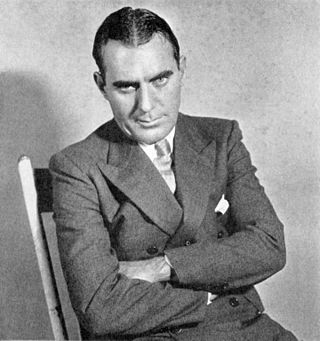
William Joseph Patrick O'Brien was an American film actor with more than 100 screen credits. Of Irish descent, he often played Irish and Irish-American characters and was referred to as "Hollywood's Irishman in Residence" in the press. One of the best-known screen actors of the 1930s and 1940s, he played priests, cops, military figures, pilots, and reporters. He is especially well-remembered for his roles in Knute Rockne, All American (1940), Angels with Dirty Faces (1938), and Some Like It Hot (1959). He was frequently paired onscreen with Hollywood star James Cagney. O'Brien also appeared on stage and television.

The Mayor of Hell is a 1933 American pre-Code Warner Brothers film starring James Cagney. The film was remade in 1938 as Crime School with Humphrey Bogart taking over James Cagney's role and Hell's Kitchen with Ronald Reagan in 1939.

The Strawberry Blonde is a 1941 American romantic comedy film directed by Raoul Walsh, starring James Cagney and Olivia de Havilland, and featuring Rita Hayworth, Alan Hale, Jack Carson, and George Tobias. Set in New York City around 1900, it features songs of that era such as "The Band Played On", "Bill Bailey", "Meet Me in St. Louis, Louie", "Wait Till The Sun Shines Nellie", and "Love Me and the World Is Mine". It was nominated for an Academy Award in 1941 for Best Scoring of a Musical Picture. The title is most often listed beginning with the word The, but the film's posters and promotional materials called it simply Strawberry Blonde.

Up Periscope is a 1959 World War II submarine film drama directed by Gordon Douglas, produced by Aubrey Schenck and starring James Garner and Edmond O'Brien. The supporting cast features Andra Martin, Alan Hale Jr., Edd Byrnes, Warren Oates and Saundra Edwards. The film was shot and processed in WarnerScope and Technicolor and was distributed by Warner Bros. The screenplay was written by Richard H. Landau and Robb White, adapted from White's novel of the same name.
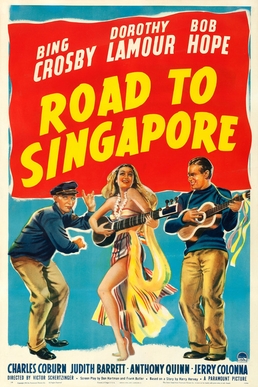
Road to Singapore is a 1940 American semi-musical comedy film directed by Victor Schertzinger and starring Bing Crosby, Dorothy Lamour and Bob Hope. Based on a story by Harry Hervey, the film is about two playboys trying to forget previous romances in British Singapore, where they meet a beautiful woman. Distributed by Paramount Pictures, the film marked the debut of the long-running and popular "Road to ..." series of pictures spotlighting the trio, seven in all. The supporting cast features Charles Coburn, Anthony Quinn, and Jerry Colonna.
Grand National Films, Inc was an American independent motion picture production-distribution company in operation from 1936 to 1939. The company had no relation to the British Grand National Pictures.

Ceiling Zero is a 1936 American adventure drama film directed by Howard Hawks and starring James Cagney and Pat O'Brien. The picture stars Cagney as daredevil womanizing pilot "Dizzy" Davis and O'Brien as Jake Lee, his war veteran buddy and the operations manager of an airline company. Based on a stage play of the same name, the film blends drama with some light comedy. The title, as defined at the beginning of the picture, is an insider term referring to those moments when the sky is so thick with fog that navigating an aircraft is nearly impossible.
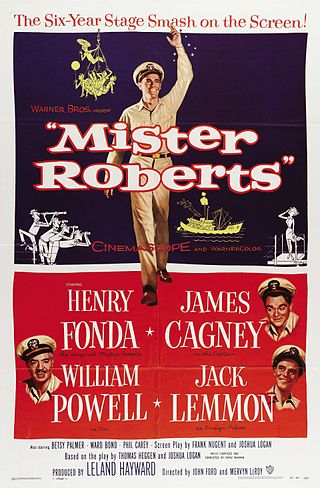
Mister Roberts is a 1955 American comedy-drama film directed by John Ford and Mervyn LeRoy featuring an all-star cast including Henry Fonda as Mister Roberts, James Cagney as Captain Morton, William Powell as Doc, and Jack Lemmon as Ensign Pulver. Based on the 1946 novel and 1948 Broadway play, the film was nominated for three Academy Awards, including Best Picture, Best Sound, and Best Supporting Actor, with Lemmon winning the latter.
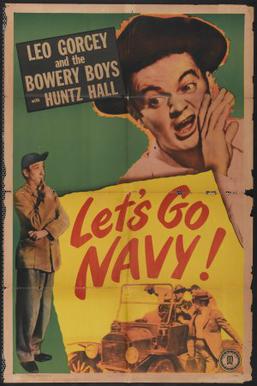
Let's Go Navy! is a 1951 comedy film starring The Bowery Boys. The film was released on July 29, 1951, by Monogram Pictures and is the twenty-third film in the series.
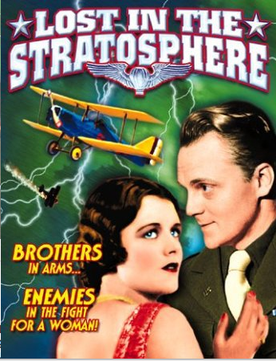
Lost in the Stratosphere is a 1934 American aviation drama film directed by Melville W. Brown and starring William Cagney, Edward J. Nugent, and June Collyer. In one of his few roles in front of the cameras, Cagney was the lookalike younger brother of James Cagney.
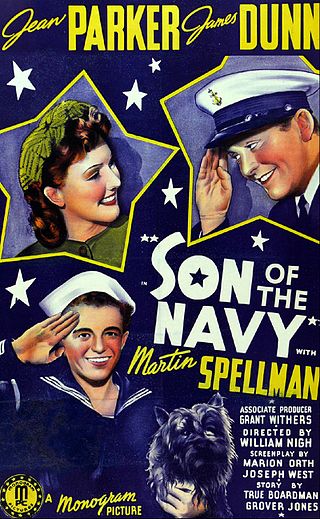
Son of the Navy, also known as The Young Recruit in the United States, is a 1940 American comedy-drama film directed by William Nigh and starring Jean Parker, James Dunn, and Martin Spellman.

Devil Dogs of the Air is a 1935 Warner Bros. film, directed by Lloyd Bacon and starring James Cagney and Pat O'Brien, playing similar roles as close friends after making their debut as a "buddy team" in Here Comes the Navy. Devil Dogs of the Air was the second of nine features that James Cagney and Pat O'Brien made together. The film's storyline was adapted from a novel by John Monk Saunders.

Miss Pacific Fleet is a 1935 American comedy film directed by Ray Enright. The film stars Joan Blondell, Glenda Farrell, and Hugh Herbert. The film was based on the short story of the same name by Frederick Hazlitt Brennan in the Collier's magazine. It was released by Warner Bros. on December 14, 1935. Two stranded showgirls in California enter a beauty contest "Miss Pacific Fleet" to win the fare back home to New York City.

Shipmates is a 1931 American Pre-Code comedy film directed by Harry A. Pollard and written by Louis F. Edelman, Delmer Daves, Raymond L. Schrock, Frank Wead, and Malcolm Stuart Boylan. The film stars Robert Montgomery, Ernest Torrence, Dorothy Jordan, Hobart Bosworth, Cliff Edwards and Gavin Gordon. The film was released on April 25, 1931, by Metro-Goldwyn-Mayer.

